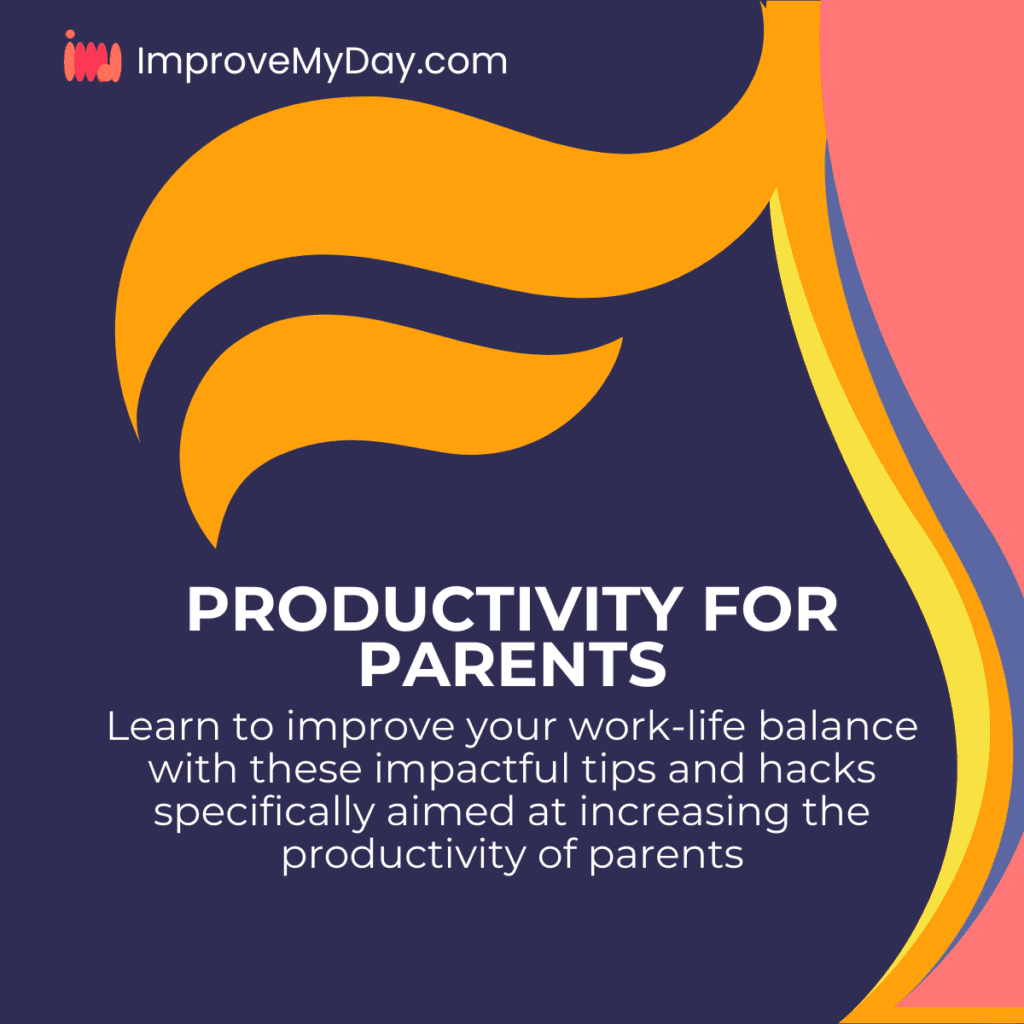Parents often find themselves caught in a perpetual juggling act, trying to balance the demands of their careers with the needs of their families. The challenge of maintaining productivity while nurturing family relationships can seem daunting, but with the right strategies and mindset, it’s possible to achieve a harmonious work-life integration. This comprehensive guide offers practical productivity tips for parents seeking to balance work and family life effectively.
The Parental Productivity Paradox
Parents face a unique set of challenges when it comes to productivity. On one hand, they have the motivation to excel in their careers and provide for their families. On the other, they have the deep-seated desire to be present and engaged in their children’s lives. This tension often leads to what we might call the “parental productivity paradox” – the struggle to be efficient at work while also being an attentive and involved parent.
According to a study by the Pew Research Center, 59% of full-time working parents say they don’t have enough time to spend with their children. This statistic underscores the importance of finding effective ways to balance work and family life. By enhancing productivity, parents can create more quality time for their families without sacrificing their professional goals.
Time Management Strategies for Busy Parents
Prioritization: The Foundation of Parental Productivity
The first step in mastering the work-family balance is learning to prioritize effectively. As James Clear, author of “Atomic Habits,” often emphasizes, “You do not rise to the level of your goals. You fall to the level of your systems.” For parents, this means creating a system of prioritization that aligns with both work and family values.
Try implementing the Eisenhower Matrix, a simple but powerful tool for prioritizing tasks:
- Urgent and Important: Do these tasks immediately.
- Important but Not Urgent: Schedule these tasks for later.
- Urgent but Not Important: Delegate these tasks if possible.
- Neither Urgent nor Important: Eliminate these tasks.
By categorizing your responsibilities this way, you can focus on what truly matters and reduce time spent on less critical activities.
Creating Effective Schedules
Once you’ve prioritized your tasks, the next step is to create a schedule that accommodates both work and family commitments. Here are some tips for effective scheduling:
- Use a digital calendar to keep track of all family and work events.
- Color-code activities for easy visual recognition.
- Schedule family time with the same importance as work meetings.
- Build in buffer time between activities to account for unexpected delays.
The Power of Time-Blocking
Time-blocking is a technique where you divide your day into blocks of time, each dedicated to accomplishing a specific task or group of tasks. This method can be particularly effective for parents trying to balance multiple responsibilities.
For example:
- 6:00 AM – 7:30 AM: Morning routine and breakfast with family
- 8:00 AM – 11:00 AM: Focused work time
- 11:00 AM – 11:30 AM: Check and respond to emails
- 11:30 AM – 1:00 PM: Lunch and quick household chores
- 1:00 PM – 4:00 PM: Afternoon work sessions
- 4:00 PM – 8:00 PM: Family time (including dinner, homework help, and bedtime routines)
- 8:00 PM – 9:00 PM: Personal time or additional work if necessary
By adhering to a time-blocked schedule, you create structure in your day and reduce decision fatigue about what to do next.
Maximizing Productivity at Work
The Power of Focused Work Sessions
To make the most of your work time, implement the concept of “deep work,” coined by author Cal Newport. This involves periods of intense, distraction-free concentration on a single task. For parents, this might mean:
- Communicating your need for uninterrupted time to colleagues and family members.
- Using noise-cancelling headphones to signal you’re in a focused work mode.
- Turning off notifications on your devices during these periods.
Minimizing Distractions
Distractions can be particularly challenging for parents, as family matters often demand immediate attention. To minimize disruptions:
- Set up a dedicated workspace, even if it’s just a corner of a room.
- Use website blockers to prevent access to time-wasting sites during work hours.
- Establish “do not disturb” hours with your family, when possible.
Efficient Communication Strategies
Streamline your work communications to save time and reduce stress:
- Use the “two-minute rule“: If a task takes less than two minutes, do it immediately rather than scheduling it for later.
- Batch your emails and messages, checking them at set times rather than continuously throughout the day.
- Utilize communication tools that allow for quick, efficient exchanges, such as Slack or Microsoft Teams.
Streamlining Household Responsibilities
Meal Planning and Prep
One of the most time-consuming aspects of family life is meal preparation. Streamline this process by:
- Planning meals for the week in advance.
- Prepping ingredients or entire meals during less busy times, such as weekends.
- Utilizing time-saving appliances like slow cookers or pressure cookers.
Organizing Family Tasks and Chores
Create a system for managing household tasks:
- Use a family calendar or task management app to assign and track chores.
- Implement a “10-minute tidy” routine where everyone in the family spends 10 minutes cleaning up before bedtime.
- Create stations for common activities (homework, bill paying, laundry) to keep supplies organized and easily accessible.
Decluttering and Simplifying the Home Environment
A cluttered home can lead to a cluttered mind. Take steps to simplify your living space:
- Regularly purge unnecessary items.
- Adopt a “one in, one out” rule for new purchases.
- Create designated spaces for everything and ensure items are returned after use.
Leveraging Technology for Better Work-Life Balance
Productivity Apps and Tools
Harness the power of technology to enhance your productivity:
- Use task management apps like Todoist or Trello to organize both work and family responsibilities.
- Try time-tracking apps like RescueTime to understand where your time is being spent.
- Utilize calendar apps with sharing capabilities to keep the whole family on the same page.
Automation of Routine Tasks
Identify tasks that can be automated to free up your time:
- Set up automatic bill payments.
- Use smart home devices to automate lighting, temperature control, and security.
- Explore grocery delivery services or meal kit subscriptions to reduce shopping and meal planning time.
Self-Care and Personal Time Management
The Importance of Self-Care for Productivity
It’s crucial to remember that taking care of yourself is not selfish – it’s necessary for maintaining high productivity and being present for your family. As the saying goes, “You can’t pour from an empty cup.”
Incorporate self-care into your routine:
- Schedule regular exercise, even if it’s just a 20-minute walk.
- Practice mindfulness or meditation to reduce stress and improve focus.
- Ensure you’re getting adequate sleep – aim for 7-9 hours per night.
Strategies for Finding Personal Time
Finding time for yourself can seem impossible, but it’s essential. Try these strategies:
- Wake up 30 minutes earlier to enjoy some quiet time before the day begins.
- Use your lunch break for personal activities or relaxation.
- Trade childcare duties with your partner or other parents to create pockets of free time.
Involving Family Members in Productivity Efforts
Age-Appropriate Responsibilities for Children
Engaging children in household tasks not only lightens your load but also teaches them valuable life skills. Assign age-appropriate chores such as:
- Toddlers: Picking up toys, putting dirty clothes in the hamper.
- School-age children: Making their bed, helping with laundry, setting the table.
- Teenagers: Cooking simple meals, doing their own laundry, helping with grocery shopping.
Partner Collaboration and Support
Open communication with your partner is crucial for maintaining a productive household:
- Regularly discuss and divide household responsibilities.
- Be flexible and willing to adjust duties as needed.
- Support each other’s career and personal goals.
Flexible Work Arrangements and Boundaries
Negotiating Flexible Work Options
If possible, explore flexible work arrangements with your employer:
- Discuss options for remote work or flexible hours.
- Consider compressed workweeks or job-sharing opportunities.
- Propose a trial period to demonstrate how flexible arrangements can benefit both you and the company.
Setting Clear Boundaries Between Work and Family Time
Establishing boundaries is essential for maintaining a healthy work-life balance:
- Define your work hours and stick to them as much as possible.
- Create a “shutdown ritual” to signal the end of your workday.
- Resist the urge to check work emails during family time.
Overcoming Guilt and Managing Expectations
Dealing with Parental Guilt
Many parents struggle with guilt about not doing enough for their work or their family. Remember:
- Perfect balance is a myth – aim for harmony instead.
- Quality of time often matters more than quantity.
- Your efforts to balance work and family life set a positive example for your children.
Realistic Goal-Setting
Set achievable goals that align with your values and current life stage:
- Break larger goals into smaller, manageable tasks.
- Celebrate small wins and progress.
- Regularly reassess and adjust your goals as your family’s needs change.
Conclusion: Embracing Imperfection and Continuous Improvement
Balancing work and family life is an ongoing process, not a destination. As James Clear wisely notes, “You do not have to be the best, you just have to be better than you were yesterday.” Embrace imperfection, learn from your experiences, and continually refine your approach to productivity.
Remember that what works for one family may not work for another. Be patient with yourself as you discover the strategies that best fit your unique situation. By implementing these productivity tips and remaining flexible, you can create a more harmonious balance between your professional ambitions and your family life.
Ultimately, the goal is not to achieve a perfect balance, but to create a life that reflects your values and priorities. With persistence and the right tools, you can build a productive and fulfilling life that allows you to thrive both at work and at home.



